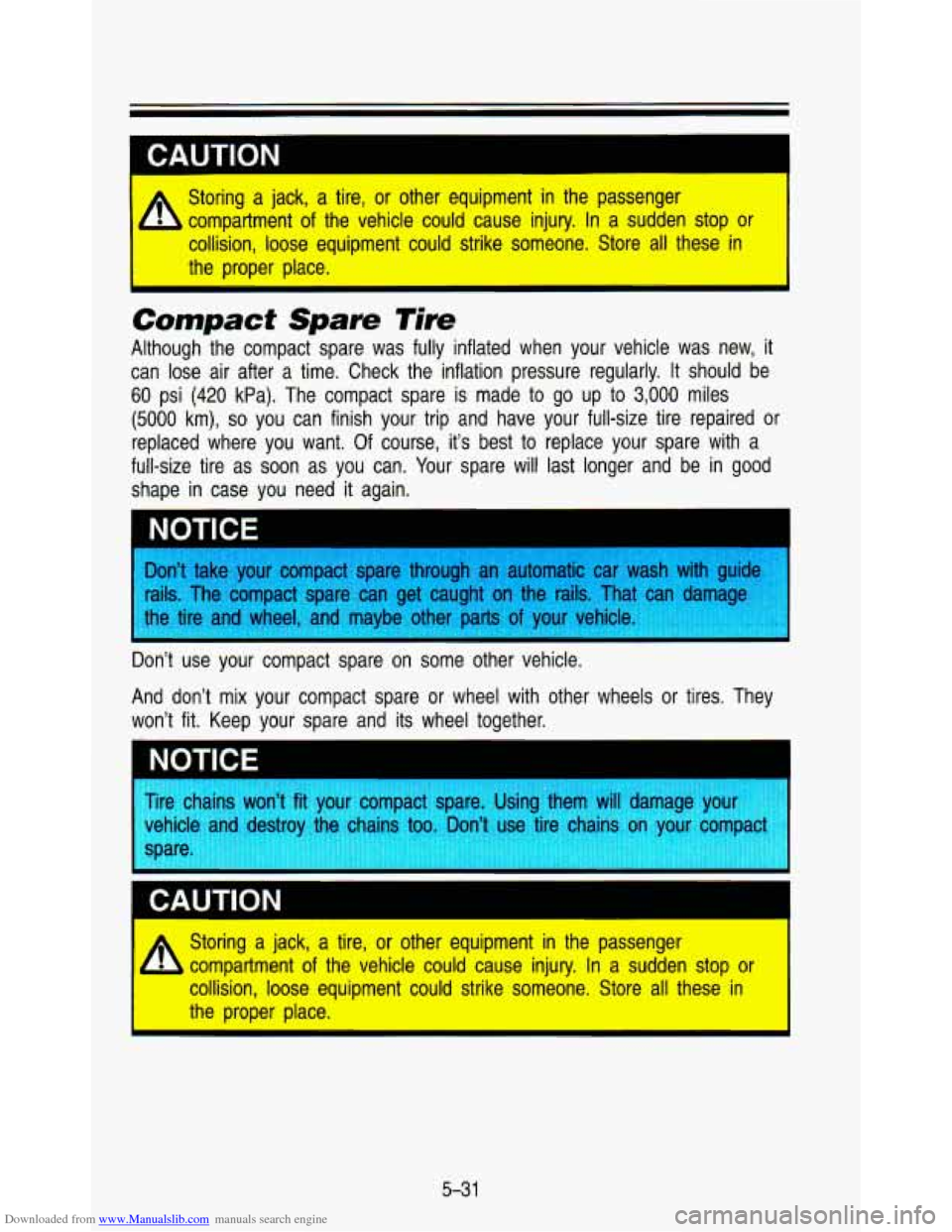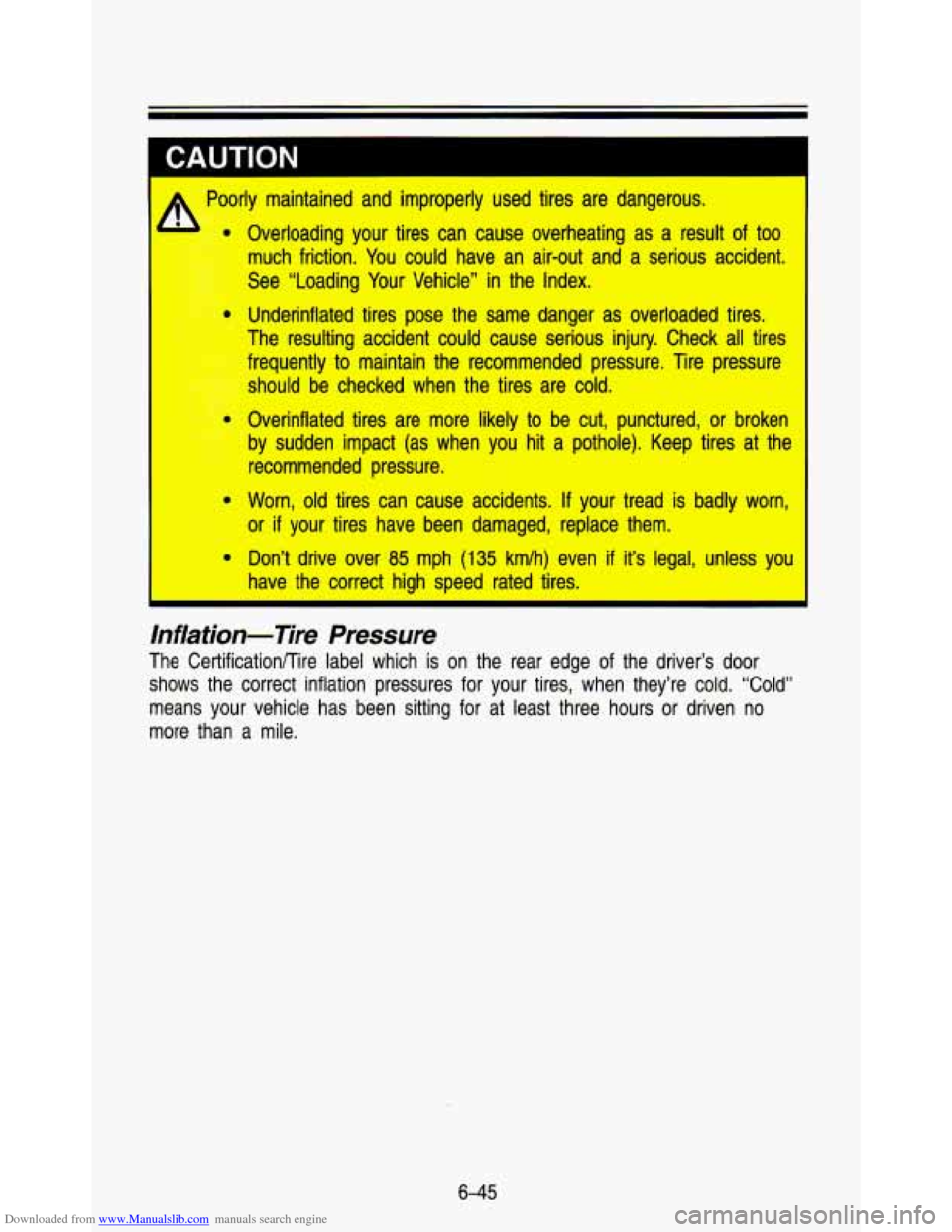Page 227 of 345
Downloaded from www.Manualslib.com manuals search engine ...._I pw: .. . . . , , . . .
.. , , . . . . . . .
.. . . .. .. . .. . . . . . . . . . .. . .. . .. ,. . . . . . . . . .. ..
. . . .. .. . . . .. .. .. . .
PO456
You have two wheel blocks stored with your jack. Place blocks at the front
and rear
of the tire farthest away from the one being changed. That would
be the tire
on the other side of the vehicle, at the opposite end.
Put your spare tire near the flat tire. Remove the wheel trim.
I ,, '-..
--.-
If there is a wheel cover, remove it by using the flat end of the extension.
Pry along the edge of the wheel cover until it comes off. Be careful; the rim
edges may be sharp. Don't
try to remove it with your bare hands.
5-23
Page 230 of 345
Downloaded from www.Manualslib.com manuals search engine Problems on the Road
.. I ." -_ . - I 4.. I
PO463
Raise the vehicle by rotating the ratchet clockwise. Make sure the UP
marking faces you. Raise the vehicle far enough off the ground so there is
enough room for the spare tire to fit.
PO457
Remove all the wheel nuts and take off the flat tire.
5-26
Page 233 of 345
Downloaded from www.Manualslib.com manuals search engine PO465
Tighten the wheel nuts firmly in a criss-cross sequence as shown. Rotate the
ratchet clockwise with the
UP marking facing you.
* Incorrect wheel nuts or improperly tightened wheel nuts can cause
’, the wheel to become loose and even come off. This could lead to
an accident. Be sure to use the correct wheel nuts.
If you have to
replace them, be sure to get the right kind.
I
Stop somewhere as soon as you can and have the wheel nuts
tightened with a torque wrench to the proper torque.
I
For proper wheel nut torque, see “Wheel Nut Torque” in t\
he Index.
Don’t try to put a wheel cover on your compact spare tire. It won’t fit\
. Store
the wheel cover in the trunk until you have the
flat tire repaired or replaced.
I covers won’t fit on your cc I try to put a 1
cover or the Spi
Remove the wheel blocks.
5-29
Page 234 of 345
Downloaded from www.Manualslib.com manuals search engine Storing the Tire and Jack
Storing the Tire
Put the tire on the ground at the rear of the vehicle, with \
the valve stem
pointed down.
Pull the retaining bar through the center of the wheel, making sure
it is
properly attached. Attach the ratchet, with the
UP side facing you, to the
extension.
Put the flat end of the extension on an angle through the hole in the rear
door frame, above the bumper. Turn the ratchet clockwise until \
the tire is
against the underside of the vehicle.
You will hear
two “clicks” when the tire is up all the way. Try to move the
tire with your hands
to make sure it is securely in place.
Storing the Jacking Equipment
K35r
Return the jack, ratchet, extension and wheel blocks to the proper location in
the rear storage area. Replace all bolts, retainers and wing nuts in the proper
location. Secure the jacking equipment in its proper location and replace the
jack storage cover.
5-30
Page 235 of 345

Downloaded from www.Manualslib.com manuals search engine I
Storing a jack, a tire, or other equipment in the passenger
b compartment of the vehicle could cause injury. In a sudden stop or
collision, loose equipment could strike someone. Store all these\
in
I the proper place.
Compact Spare Tire
Although the compact spare was fully inflated when your vehicle\
was new, it
can lose air after a time. Check the inflation pressure regula\
rly. It should be
60 psi (420 kPa). The compact spare is made to go up to 3,000 miles
(5000 km), so you can finish your trip and have your full-size tire repaired\
or
replaced where you want. Of course, it’s best
to replace your spare with a
full-size tire as soon as you can. Your spare
will last longer and be in good
shape in case you need
it again.
Don’t use your compact spare on some other vehicle.
And don’t mix your compact spare or wheel with other wheels\
or tires. They
won’t fit. Keep your spare and its wheel together.
Tire chains won’t fit your compact spare. Using them will d\
amage your vehicle and destro) “re chc”? too. Don’t use
ti- chair - 3n your compacl
spare.
A
Storing a jack, a tire, or other equipment in the passenger
compartment
of the vehicle could cause injury. In a sudden stop or
collision, loose equipment could strike someone. Store all these\
in
the proper place.
I
5-3 1
Page 278 of 345

Downloaded from www.Manualslib.com manuals search engine Service & Appearance Care
Loading Your Vehicle
K3651
The Certificationrrire label is found on the rear edge of the driver’s door. The
label shows the size of your original tires and the inflation pressures needed
to obtain the gross vehicle weight capacity of your vehicle. This is called the
GVWR (Gross Vehicle Weight Rating). The GVWR includes the weight of the
vehicle, all occupants, fuel and cargo.
The Certificationflire label also tells you the maximum weights for the front
and rear axles, called Gross Axle Weight Rating (GAWR).
To find out the
actual loads on your front and rear axles, you need
to go to a weigh station
and weigh your vehicle. Your dealer can help you with this. Be sure
to
spread out your load equally on both sides of the centerline.
Never exceed the GVWR for your vehicle, or the Gross Axle Wei\
ght Rating
(GAWR) for either the front or rear axle.
And,
if you do have a heavy load, you should spread it out.
Do not load your vehicle any heavier than the GVWR or the
- maximum front and rear GAWRs. If you do, parts on your vehicle
can break, or
it can change the way your vehicle handles. These
could cause you
to lose control. Also, overloading can shorten the
life
of your vehicle. I
6-42
Page 281 of 345

Downloaded from www.Manualslib.com manuals search engine A Poorly maintained and improperly used tires are dangerous. Overloading your tires can cause overheating as a result of too
much friction.
You could have an air-out and a serious accident.
See “Loading Your Vehicle” in the Index.
Underinflated tires pose the same danger as overloaded tires.
The resulting accident could cause serious injury. Check all ti\
res
frequently to maintain the recommended pressure. Tire pressure
should be checked when the tires are cold.
Overinflated tires are more likely to be cut, punctured, or broken
by sudden impact (as when you hit a pothole). Keep tires at\
the recommended pressure.
Worn, old tires can cause accidents.
If your tread is badly worn,
or
if your tires have been damaged, replace them.
Don’t drive over
85 mph (1 35 km/h) even if it’s legal, unless you
have the correct high speed rated tires.
Inflation-Tire Pressure
The Certification/Tire label which is on the rear edge of the driver’s door
shows the correct inflation pressures for your tires, when they’re cold\
. “Cold”
means your vehicle has been sitting for at least three hours \
or driven no
more than a mile.
6-45
Page 282 of 345
Downloaded from www.Manualslib.com manuals search engine Senrice & Appearance Care
on’t let anyone tell you that underinflation or overinflation is all right. It’s
When to Check: Check your tires once a month or more. Don’t forget your
compact spare tire.
It should be at 60 psi (420 kPa).
How to Check: Use a good quality pocket-type gage to check tire pressure.
Simply looking at the tires will not tell you the pressure, e\
specially
if you
have radial tires-which may look properly inflated even
if they’re
underinflated.
If your tires have valve caps, be sure to put them back on. They help
prevent leaks by keeping out dirt and moisture.
6-46